This is the final in a series of seven blogs that focus on several areas of interoperability testing, including Segment Routing, EVPN, SDN Controllers, Network Automation and Timing & Synchronization. The test report is publicly available and can be found here. See part six on Network Automation here.
In March 2020, Juniper Networks participated in the EANTC MPLS+SDN+NFV World Congress Interoperability event to demonstrate a wide array of interoperability use cases. This blog highlights the timing and synchronization feature capabilities of the Juniper MX Series router & QFX Series switch and the results of the testing.
As mobile technologies have evolved from 2G to 4G and now 5G, synchronization requirements are becoming tighter and harder to achieve, creating the need for accurate, modern and reliable synchronization solutions. Timing and synchronization in the 5G context involve Physical Layer Synchronous Ethernet (Sync-E) and IEEE 1588v2 Precision Timing Protocol (PTP). Sync-E (ITU-T G.8262 and ITU-T G.8264) is a physical layer technology that functions regardless of the network load and supports hop-by-hop frequency transfer, where all nodes on the trail must support Synchronous Ethernet. PTP provides the phase and time required for the clock. PTP is a packet-based technology that enables the operator to deliver synchronization services on packet-based mobile backhaul networks. IEEE 1588 PTP (Version 2) clock synchronization standard is a highly precise protocol for time synchronization that synchronizes clocks in a distributed system.
The 3GPP standard specifies phase accuracy of +/-1.5usec for TDD (Time Division Duplex) networks. 5G NR in the mid and high bands will always be using TDD (many 2G to 4G networks in the world today have been using FDD – Frequency Division Duplex). The ITU-T G8275.1 Telecom Profile addresses these phase requirements in 5G networks. Figure 1 shows an example network model consisting of Class-B Telecom Boundary Clocks in full path timing support network with the time error budget.
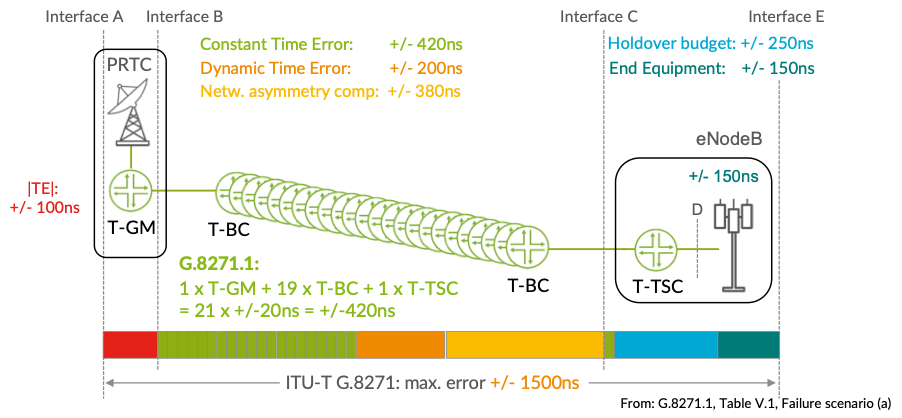
Juniper Routing Platforms, including the MX, support advanced timing solutions that consist of accurate hardware (targeting a minimum of Class B) including high stratum OCXO, PHY/MAC timestamping and Advanced Phase Locked Loops (PLL) for jitter/wander performance. Juniper’s in-house PTP software stack provides Ethernet (VLAN tags), IPv4/IPv6 encapsulations, multiple timing profiles (ITU-T, IEEE, IETF and SMPTE) with hybrid mode support for enhanced stability and extended holdover. The Juniper MX/ACX routers support timing on interfaces speed range from 1 to 400 GbE with a variety of client optics and scaled up number of timing clients (up to 512 clients on ACX series and up to 256 clients on MX).
At the EANTC 2020 event, Juniper participated in test cases with 5G synchronization requirements (Sync-E and PTP), resiliency scenarios involving source failover between two grandmaster clocks with high precision clocking and delivery of timing in optimal and sub-optimal conditions.
Juniper successfully tested the MX204 router and QFX5110-48S switch in different test cases, with the MX204 used in 5G IP transport networks and the QFX5110-48S used in data center and enterprise use cases. Juniper routers support the key features needed to achieve the +/- 1.5 microsecond accuracy that 5G demands from the synchronization. With hardware PHY time stamping implemented on the Juniper products like MX routers and QFX switches, we can achieve high precision and accurate clocking implementation.
Phase/Time Partial Timing Support
This network model is used when some of the network devices do not have full timing support between grandmaster and end slave clocks. The PTP Telecom profile for phase synchronization with partial timing support has been defined in the ITU-T G.8275.2 profile.
This test setup emulates the Partial Timing Support case by using the impairment test tool between the Grand Master(GM) and Boundary Clock (BC) .
- The Juniper QFX5110-48S switch is the boundary clock.
- The impairment tool applied with the Packet Delay Variation (PDV) profile according to ITU-T G.8261 test case 12.
- The boundary clock is able to phase-lock towards the grandmaster when the impairment tool was running.
- This test case shows that not all the devices in the IP transport network need to be BC enabled to meet the phase synchronization by using the G.8275.2 profile.
- ITU-T G.8275.2 profile was tested between the grandmaster and boundary clocks without any Sync-E.
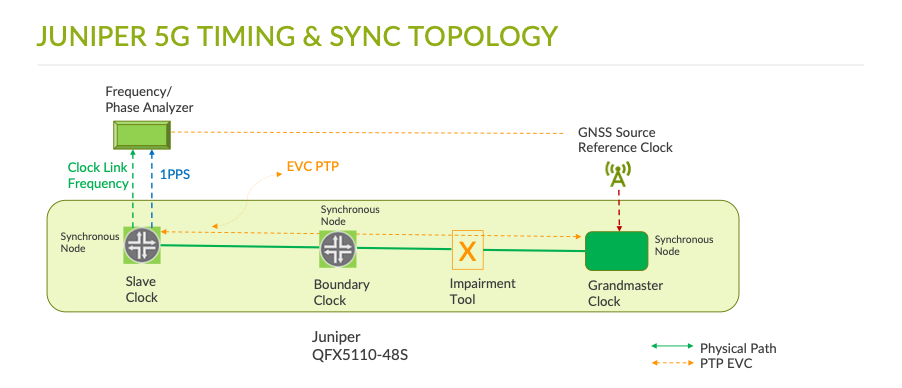
Phase/Time Synchronization, Source Failover
Today’s IP transport networks are built with redundancy and the clocking solution must also support this to ensure there is no single point of failure in the architecture. There must be a primary and a secondary grandmaster provided to the clocking solution. This includes the GMs, boundary clock and the slave clocks for PTP. The boundary clock selects the primary GM with the best clock quality based on the algorithm defined in the G.8275.1 telecom profile.
In this test case, the scenario included:
- Two GM Clocks, a BC and a slave clock.
- The MX204 router is the boundary clock in this test case.
- The boundary clock in steady state is locked (phase aligned) to the primary grandmaster (A) with the Grand Master Clock (GMC) Class of 6.
- The GM (A) was subsequently degraded by unplugging the GNSS antenna.
- The BC switched over to secondary GM (B) and we measured the slave clock’s transient response, within accuracy level 6.
- The test was performed with the G.8275.1 Telecom profile between grandmaster, boundary clock and slave clock.
- In addition, SyncE was enabled through the whole chain with an ESMC quality level (QL) of PRC.
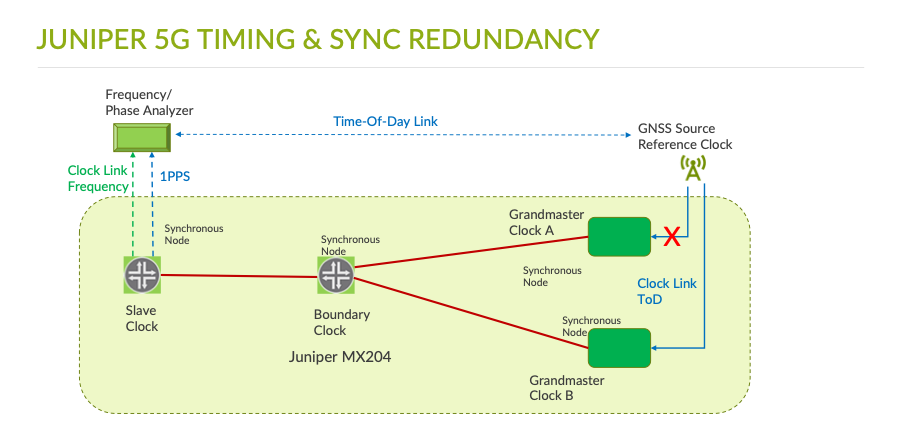
Phase/Time GNSS Vulnerability Test
Security is top of mind with every network today and is required for the GM and the GNSS receivers. Spoofing is a mechanism that makes the receiver believe it is at a false location. To protect the receiver against a spoofing attack, a GNSS security device can be used. This test verifies the GNSS firewall’s ability to detect a spoofed GNSS signal and thwart any risks to the network.
- At steady state, before the spoofing attack, the GMC Class was 6.
- The Juniper MX204 router was the slave clock 1 device in this test case.
- Start the spoofing attack.
- When the GNSS firewall detects the spoofing attack, it stopped forwarding the signal and sends and GM A downgrades the clock class to 7 by getting into holdover.
- GM B is still sending a GMC Class of 6
- If a boundary clock has access to another grandmaster clock in the network, the Best Master Clock Algorithm (BMCA) will then lock to another grandmaster if it sees a GMC Class of 6, which is better than 7.
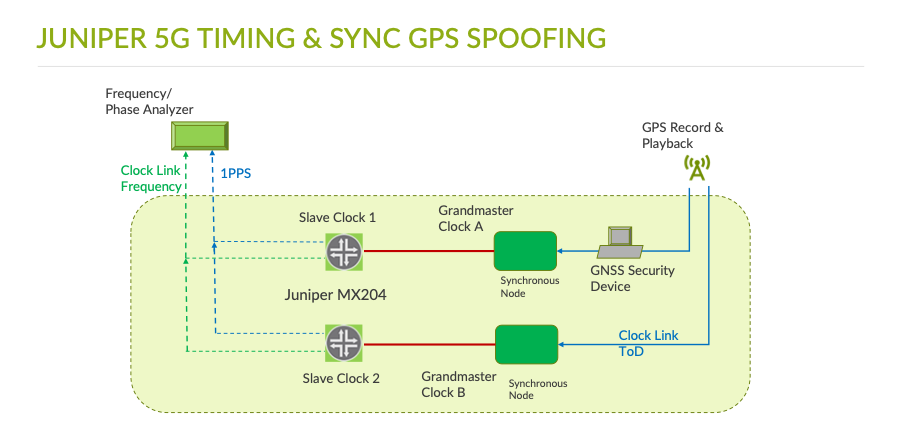
The Juniper Advantage
When it comes to high precision phase synchronization, there are different timing profiles defined by the ITU-T SG15/Q13 standards body. The two standards profiles for phase synchronization are:
- 8275.1 – Full-path Timing Support (FTS) profiles.
- 8275.2 – Partial-path Timing Support (PTS) and Assisted Partial-path Timing Support (A-PTS) profiles.
Both of these profiles are defined based on IEEE 1588v2 (precision time protocol – PTP) standard. Similarly, in case of frequency synchronization over packet networks, there are few standards defined:
- 8265.1 – Frequency synchronization using PTP protocol
- 8262 – Physical layer clock synchronization using Synchronous Ethernet
- 8262.1 – Physical layer clock synchronization using Enhanced Synchronous Ethernet
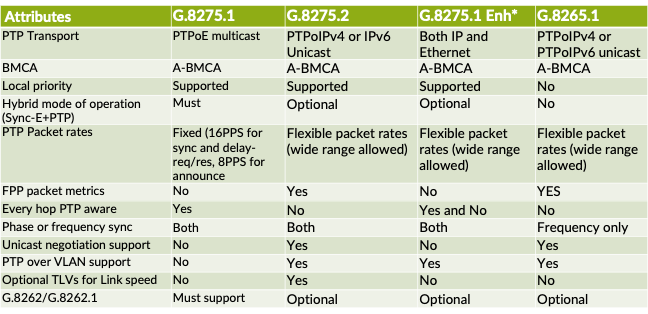
Juniper offers a set of unique profiles and features, where customers can combine the use from both G.8275.1 and G.8275.2 profiles, shown in the table below.
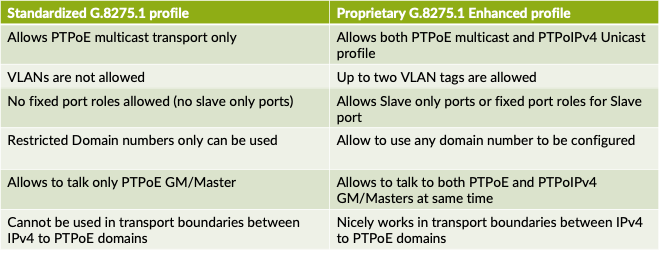
Juniper Technology Fuels the ‘Cloud + 5G + AI’ Era Transformation
With open, interoperable solutions, Juniper is providing a new generation of networking infrastructure to help our customers succeed in the ‘Cloud + 5G + AI’ era. Juniper continues to innovate and showcase leadership in Timing & Synchronization with a strong focus on the following attributes:
- 5G synchronization requirements
- Resiliency scenarios and PTP implementation
- Source failover between two grandmaster clocks with high precision clocking
- Delivery of the time signal in optimal as well as sub-optimal conditions
- Extended hold-over performance
Innovations like these don’t always capture the headlines. But talk to service providers and you’ll quickly realize that this is where the real revolution begins – in the trenches.
Join interactive breakout sessions and explore how to realize the benefits of Cloud + 5G + AI. Register for our Juniper Virtual Summit for Cloud & Service Providers on June 10 (US/EMEA) and June 11 (APAC) here.

























